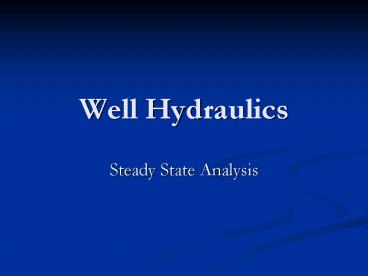Well Hydraulics - PowerPoint PPT Presentation
1 / 24
Title:
Well Hydraulics
Description:
... the permeability in gallons per day per square foot and r and h are measured in feet. m is the thickness of aquifer (same as b in previous case) ... – PowerPoint PPT presentation
Number of Views:1206
Avg rating:3.0/5.0
Title: Well Hydraulics
1
Well Hydraulics
- Steady State Analysis
2
Groundwater Wells
- The groundwater is collected through the use of
wells - Well systems usually have well structure, pump
and discharge pipes - Well usually consists of perforated casing that
allows water to enter the well but prevents
collapse of hole - When waster is withdrawn, the flow becomes
established to compensate the withdrawl - Because of head loss, piezometric surface
adjacent to well is depressed this is called
cone of depression - Remember Darcys equation
3
- ?? What is well hydraulics?
- To understand the processes in effect when one or
- more wells are pumping from an aquifer. This for
- instance considers the analysis of drawdown due
to - pumping with time and distance
- ?? Importance of well hydraulics
- Groundwater withdrawal from aquifers are
important - to meet the water demand. Therefore, we need to
- understand well hydraulics to design a pumping
- strategy that is sufficient to furnish the
adequate - amounts of water
4
Basic Assumptions
- The piezometric surface of the aquifer is
horizontal prior to the start of the pumping - The aquifer is homogeneous and isotropic (same
material with same properties in all directions) - All flow is radial toward the well
- Groundwater flow is horizontal
- Darcys law is valid
- The pumping well fully penetrates the aquifer
5
Steady versus Transient (unsteady)
- Steady state implies that the drawdown is a
function of - location only
- Transient state implies that the drawdown is a
function - of location and time
- Thus
- h f(r) in case of steady state
- h f(r,t) in case of transient state
6
Steady Radial Flow to a Well in ConfinedAquifers
7
Steady Radial Flow to a Well in ConfinedAquifers
- When water is pumped from a confined aquifer,
- the pumpage creates a drawdown in the
- piezometric surface that induces hydraulic
- gradient toward the well
- Drawdown at a given point is the distance by
- which the water level is lowered. A drawdown
- curve shows the variation of drawdown with
- distance from the well
- The induced flow moves horizontally toward the
- well
8
Steady Radial Flow to a Well in ConfinedAquifers
- Apply Darcys law to derive the flow equation
that relates drawdown with pumping
9
Steady Radial Flow to a Well in ConfinedAquifers
- Rearranging and integrating for the boundary
- conditions at the well h hw and r rw
- and
- at the edge of the aquifer h h0 and r r0
- yields (with the negative sign neglected)
10
Steady Radial Flow to a Well in ConfinedAquifers
11
Steady Radial Flow to a Well in ConfinedAquifers
- Thiem equation
- where r1 and r2 are the distances and h1 and
- h2 are the heads of the respective observation
- wells
12
Textbook form
- where Q is in gallons per minute, Kf is the
permeability in gallons per day per square foot
and r and h are measured in feet. m is the
thickness of aquifer (same as b in previous case)
13
Steady Radial Flow to a Well in ConfinedAquifers
- From a practical standpoint, the drawdown s
- rather than the head h is measured so
14
Example 1 Steady State ConfinedAquifer
- A well in a confined aquifer is pumped at a rate
of 220 - gal/min
- Measurement of drawdown in two observation wells
- shows that after 1,270 min of pumping, no further
- drawdown is occurring
- Well 1 is 26 ft from the pumping well and has a
head of - 29.34 ft above the top of the aquifer
- Well 2 is 73 ft from the pumping well and has a
head of - 32.56 ft above the top of the aquifer.
- Use the Thiem equation to find the aquifer
transmissivity
15
Solution 1
- We must first convert the pumping rate of 220
gal/min to an equivalent rate in cubic feet per
day - Now we substitute the given values into Thiem
equation
16
(No Transcript)
17
Steady Radial Flow to a Well inUnconfined
Aquifers
18
Confined versus Unconfined
19
Steady Radial Flow to a Well inUnconfined
Aquifers
- The flow equation is similar for that of
confined aquifers except we use h instead of b
20
Steady Radial Flow to a Well inUnconfined
Aquifers
- Rearranging and integrating for the boundary
- conditions at the well, h hw and r rw, and at
the - edge of the aquifer, h h0 and r r0, yields
21
Steady Radial Flow to a Well inUnconfined
Aquifers
- Converting to heads (h1 and h2) and radii at two
- observation wells at locations r1 and r2
22
Steady Radial Flow to a Well inUnconfined
Aquifers
- Rearranging to solve for the hydraulic
conductivity
23
Textbook form of unconfined aquifer
- Where Q is in gallons per minute, Kf is in
gallons per day per square foot and r and h are
measured in feet.
24
(No Transcript)































